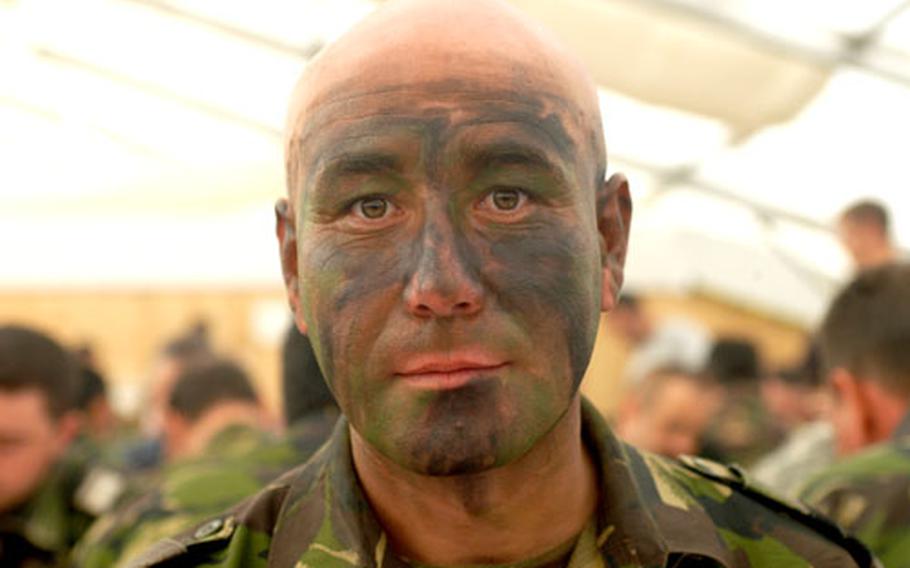
A Romanian sergeant at lunch in the Mihail Kogalniceanu air base, before a demonstration with his soldiers designed to showcase their fighting know-how and resolve. (Nancy Montgomery / Stars and Stripes)
MIHAIL KOGALNICEANU AIR BASE, Romania — Spc. David Miles considered his Romanian beer “sort of like a Corona” and his Romanian tour overall: “Probably the best deployment you have to look forward to.”
Capt. Cibrian Balica pondered his hopes that his Romanian sergeants would learn to be as responsible as American sergeants. “Officers in Romania have to do everything,” he said.
Lt. Gen. Kenneth Hunzeker surveyed the joint U.S.-Romanian military exercise, which is inaugurating the long-term U.S. military presence in a former Communist bloc nation, and smiled.
“I happened to be in the Pentagon when we dreamed this up,” Hunzeker, now V Corps commander, told a group of soldiers Sunday at the Romanian air base the U.S. calls “MK.”
“You have a lot to be proud of. This is just an incredible exercise, when you think how far we have come.”
Four years after the first public announcement that a large segment of U.S. forces would be leaving Germany for U.S. and Eastern European bases, the idea is getting its first reality test.
Called “Proof of Principle,” the exercise placing a battalion of U.S. artillerymen on an austere Romanian air base to train and live with some 100 Romanian infantrymen, began in August. It is intended to enhance joint training and “interoperability” with a new NATO member and partner in the “coalition of the willing,” which, eager for U.S. military aid, has cooperated fully with U.S. efforts in the war on terrorism.
It also was intended to test the capability of the Joint Task Force East, a new U.S. Army Europe subordinate command, to support those and future troops adequately, if not in the manner to which they’d become accustomed in Germany.
Establishing a presence in Romania means meeting some significant strategic goals for the U.S., Hunzeker said.
Among them are those stated in 2003 by then-U.S. European Commander Gen. James Jones but thought about far longer: how to reshape theater security engagement in a post-Cold War world.
“It was always a discussion — we were going to downsize Germany some day,” Hunzeker said.
In 2003, Jones talked about training opportunities in Eastern Europe — more hours available, more aircraft and bigger bombs allowed, fewer environmental regulations — than in Germany.
He talked about less expense by bringing units back to the U.S. and moving them for shorter periods to smaller, Spartan bases — which also are closer to the Middle East, the Balkans and Africa — and not positioned like those in Germany for a defunct Cold-War constraint against the Soviet Union.
Much of that thinking holds true, Hunzeker said.
Despite start-up costs on the air base — more than $30 million spent by the Air Force in the last five years and some $63 million being spent by the Army through the next fiscal year — “In the long-run, it is less expensive,” Hunzeker said. “It allows you to reduce your footprint in Italy, Germany and England.”
“There’s no doubt it’s closer to trouble spots,” Hunzeker continued. “It does get you more forward presence.”
But the Romanian base is configured for training, not as a forward operating base, Hunzeker said. Troops could not currently deploy to trouble spots from there, he said.
“It would be a totally different construct,” Hunzeker said. “It’s not in the current plans. But we’ll build relations. We’ll know where to go.”
Coalition-building is something U.S. Army Europe commander Gen. David McKiernan has emphasized. “We don’t talk about if it’s the right thing,” Hunzeker said. “We talk about how to do it.”
The Romanian-U.S. operations at the base have upset last century’s major U.S. foe — Russia — which has assailed the base as a global threat that could increase tensions in the region, according to the International Herald Tribune. President Vladimir Putin cited the facility as one reason Russia recently decided to suspend membership in an important defense agreement, the Conventional Forces in Europe treaty, the newspaper said.
More than halfway through the exercise, Americans and Romanians seemed to agree that things were going well.
U.S. troops said that despite basic-training-type living conditions for three months in large metal buildings, working six days a week and having their off-duty time more restricted than in Germany, they’ve enjoyed training in Romania. They point out it’s far less onerous than going to Iraq or Afghanistan.
The Romanians seemed friendly and eager, U.S. troops agreed, if not all proficient in English. Pointing worked well, they said. And soldiers said they also were impressed by some Romanian tactics, such as the way they clear a building. “We’ll kick obstacles out of the way. They’ll go over it and around it,” said Staff Sgt. Jeremy Staffer. “When they explained it, it made sense: booby-traps.”
V Corps Sgt. Maj. Ralph Beam said that training was on track but more support was needed for soldiers’ quality of life.
“They’ve got nine computers for 700 people,” he said. “That was probably the biggest complaint (soldiers) had. The other thing is they’re not TDY, they’re not deployed, they’re sort of in limbo. It’s like going to Graf.”
Romanian soldiers said the U.S. presence would help them make their Army more professional and prepared for future joint operations. “This is a great opportunity to train on tactics and procedures,” Balica said. “We’ll know the acronyms — that’s a huge thing.”
Equally important, U.S. troops also would bring money and jobs to the surrounding communities, he said.
Balica, who said the key to the Romanian character was that “the Romanian will be able to make a joke on his most miserable day,” said he couldn’t think of a downside to the American presence.
They were noticeable, though. “They talk loud,” he said.